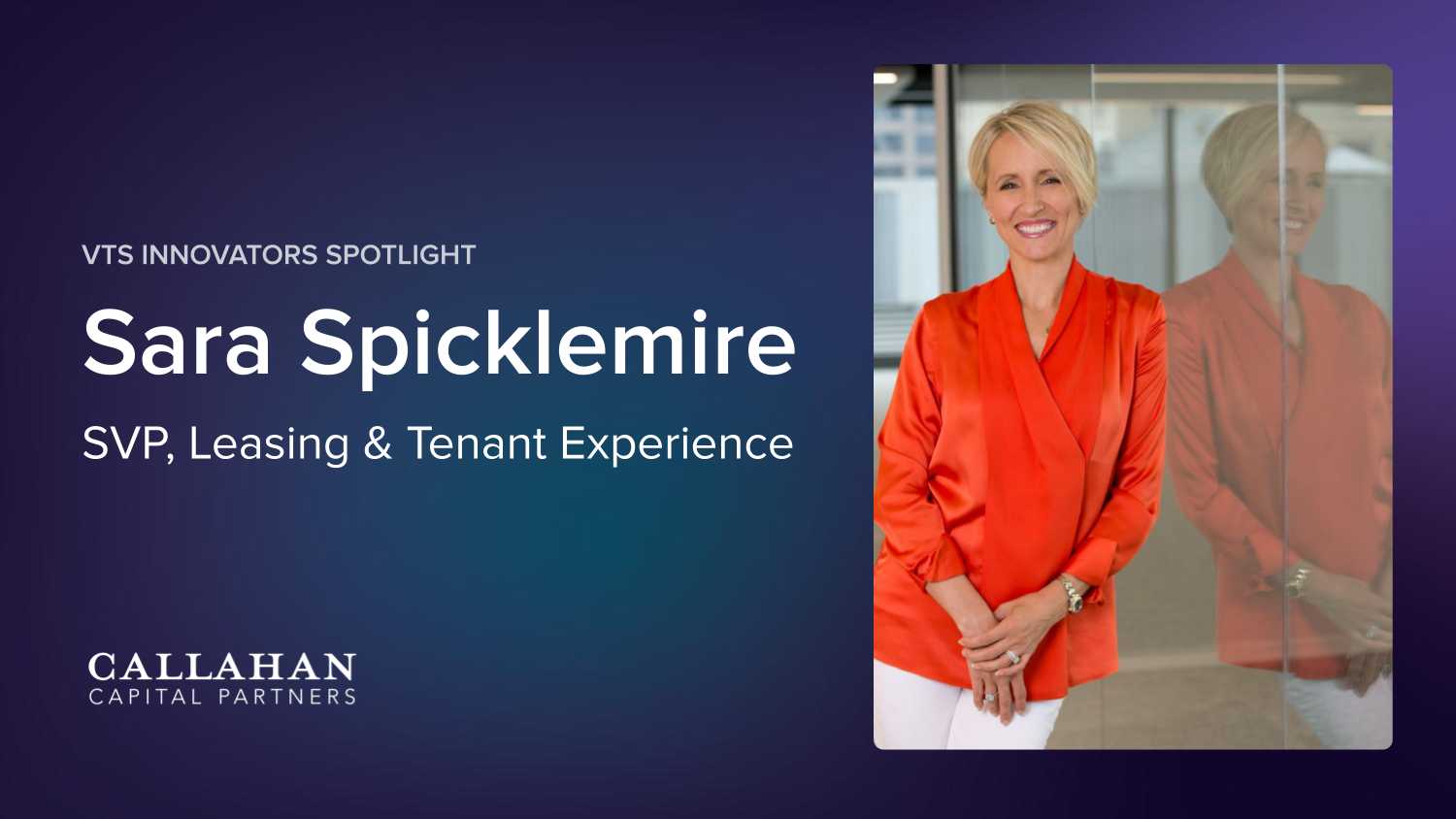In this VTS Innovators Spotlight, we spoke with Sara Spicklemire - Senior Vice President of Leasing & Tenant Experience at Callahan Capital Partners - about asset strategy in the current macroeconomic environment and why tenant experience is crucial to the overall leasing strategy.
Hi Sara! Thanks so much for taking the time to chat. Can you please tell our readers about your current role at Callahan Capital Partners and give us a quick primer on your career prior to Callahan?
Thanks for having me, Kevin. I'm the SVP of Leasing and Tenant Experience at Callahan, which means I focus on the traditional leasing function of developing and executing our leasing strategies for each building. Furthermore, to ensure those leasing goals are not only met but exceeded, a significant focus has to be on our tenant experience, so I spend time working closely with our leasing teams, our property management teams, and all of our customer-facing professionals. Customer facing includes our security professionals, engineering, janitorial - anybody who interacts with our tenant customers at any time of the day or night. I spend a significant amount of time working with the entire team on our expectations for tenant experience, including curating the amenities and services we want to offer our tenants at our buildings.
Before Callahan, I spent two decades in brokerage, working with various institutional ownership groups and multi-tenant office building owners to execute their leasing and development programs. After starting my career in tenant representation and then landlord representation at Grubb & Ellis, I was an SVP / Managing Director at a boutique firm called MB Real Estate that was bought by TransWestern before I moved on to CBRE, where I then spent about five years. While at CBRE, I had the honor of working with Tim Callahan as a client. I led a team at CBRE which leased about 11 million square feet, with roughly two million which were Callahan Capital’s. After leaving brokerage, Tim was the only person who could have called me off the bench so quickly, but it was a natural transition on the client side when the opportunity arose.
In your current role, both leasing and tenant experience are in your purview. What makes combining leasing and tenant experience under single-threaded leadership strategic?
Hospitality is one of the most adulterated words in office commercial real estate leasing. And it has been that way long before COVID. But post-COVID in particular, watered-down “hospitality” attempts fell flat. Before “flight to quality” was a buzzword, our CEO Tim Callahan predicted that the top 10-15% of buildings would continue to transact and have positive absorption while the rest of the market would struggle. Furthermore, he recognized to compete in that new paradigm, we were no longer competing with just the office tower down the road but instead thousands of home offices. We had to look at every single employee's home office as competition and create a really good reason to come back to the office. To do that, we placed an immense amount of focus on the tenant experience.
So, my position was a result of his recognition that we needed to place an immense amount of focus on consistent, high-touch, truly service-oriented hospitality. Tenant experience doesn’t just begin once the lease is signed, it starts at the inquiry and ends the day that the lease (hopefully never!) expires. From the moment a tenant walks in the door on their first tour, we want them to get the sense that this is different, that we're bringing true hospitality to their day. We’re constantly raising the bar on what that means, practically, by truly listening to our tenant executives to give them the tools to engage all their employees, be more productive and efficient so they want to come into the office.
“Tenant experience doesn’t just begin once the lease is signed.” I love that, and it’s a perspective we’re spiritually aligned to at VTS. How, then, does Callahan view technology’s place in tenant experience across the tenant lifecycle?
If people are going to make the effort to commute into the office, they want to make their workday incredibly productive. So, we're using Proptech both for in-place tenant experiences through the building app (we're actively implementing Host powered by VTS) and within our internal leasing process to make our interaction with our brokerage teams more efficient.
I spent almost 20 years in brokerage. I know I need to make it really, really easy for the brokers to provide us with the information needed to position our buildings the best for every single, unique prospect. If it's easy for the brokers, I will get the information I need so that we can position ourselves the right way in every prospective tenant negotiation.
With VTS Lease, we’ve embedded every piece of information needed on a prospect, proposal approval, milestone, and touchpoint that matters from inquiry up to the lease execution instead of having 17 Excel spreadsheet checklists requiring manual updates. With VTS you've got all the information that you need to be nimble, to be quick, to adapt to whatever that deal transaction requires. Additionally, it’s been helpful for us as the operating partner because it also creates an audit trail. It's all in one place and there's a timestamp on who checked the box when it got done.
You've seen several office market cycles come and go in your career, and you've maintained success throughout all that. What do you think makes this current market cycle unique? And given the current market cycle, what has changed in your approach to developing asset strategy?
There's such a fundamental change in how people use office space. You can no longer rest on anecdotes, thinking you're better than the building down the street. You have to literally give people a reason to walk away from their home office because that's the true competition right now. That's the biggest differentiator for this market cycle, versus having gone through a couple of bubble bursts where usually it’s a matter of time before things autocorrect. This is different.
In terms of thinking through asset strategy, we also recognize there's a fundamental shift in our societal approach to working and an intense focus on health and wellness. We really have to focus on what truly moves the needle to enhance employee productivity and efficiency, to meet their needs holistically as an individual, as a human being, because tenants have already figured out how to care for themselves and their families from their home office. As an owner, we’re leaning into how to keep tenants just as productive (as they are at home) if they're going to sacrifice some time coming into the office.
Converse to the previous question - what do you think has been consistent in the way you’ve operated over time that’s helped you remain successful, regardless of the macro environment?
You have to focus on people. They are the core of everything. I just read a very good book recently - I'll steal a quote from it, Admiral Robert Harward's new book, The Gouge, where he discusses how we all have a contract with humanity and that sharing the best of everyone for the collective wellbeing is an ideal that you have to carry forward. Whether that's your colleagues or customers you have to focus on people to create a better experience for everyone. It's not just a job. It's not just a paycheck. We train our teams on the front lines of hospitality to think that way so they enjoy coming to work every day excited to engage with people.
That’s awesome, great answer! Going to back to the market cycle topic - how is Callahan dissecting this moment in time? Are you actively vetting strategic investment opportunities, and if so - how are you and your team analyzing the market to reach conviction on potential investments?
We are 100% in full-blown acquisition mode, looking for opportunities across 14 markets nationally. When we first started looking at the post-COVID market, before flight to quality was a buzzword, we knew there was an opportunity in the top 10-15% of the newest assets with the best amenities and best location to outperform and buck the negative headlines. In many markets, we have seen these top assets lease up with no, or very little, new development in the pipeline. As the top of the market gets tighter, and the flight to quality - or as I prefer to say “flight to experience” - continues, we’re now also pursuing well located assets that might need some upgrades but have the right bones and with the right investment post-acquisition we can create that commute-worthy experience with better amenities, services, and employee wellness.
To get our arms around each market, we dig deep into our robust network within those markets and sit down with all the “boots on the ground” experts to discern whether certain doomsday headlines in their local markets are correct or incorrect. Between these efforts and leaning on real time VTS Data, we’ve been able to truly understand what’s going on beyond the market statistics for our target acquisition asset niche and put together investor decks that substantiate why all the headlines you're reading about in DC, Chicago, New York, etc. are not always the full story.
Has there been anything utterly shocking in terms of a submarket that is outperforming the negative headlines?
The biggest shocker for us was the DC market. DC gets pummeled with negative headlines. I suspected we’d uncover a different story but didn't appreciate how great of a story it would be. DC is a market where you have to buy carefully, literally corner by corner, street by street correctly. When you start looking at the top of the market that attracts Fortune 100 law firms, there are some really good supply/demand fundamentals. We did our market deep dive for the quarter and walked out with a very different picture than the media painted. We looked at VTS’s forward-looking demand data when we put together our analysis to present to investors. We were impressed with where things are going as far as how much demand there is out there for prime space, and how little of the prime space there is.
[_______] is what will separate the winners and losers in commercial leasing, particularly in office over the next five years.
Beyond the obvious answer of capital, since it all takes money, it's going to be location and the tenant experience, because those are the two biggest hurdles to get people back to the office consistently. Employees are asking themselves “How long do I have to commute and what's it like when I'm there?” So we need to bring that next-level hospitality experience, a truly commute worthy experience, to get them to the office and keep them coming back.






